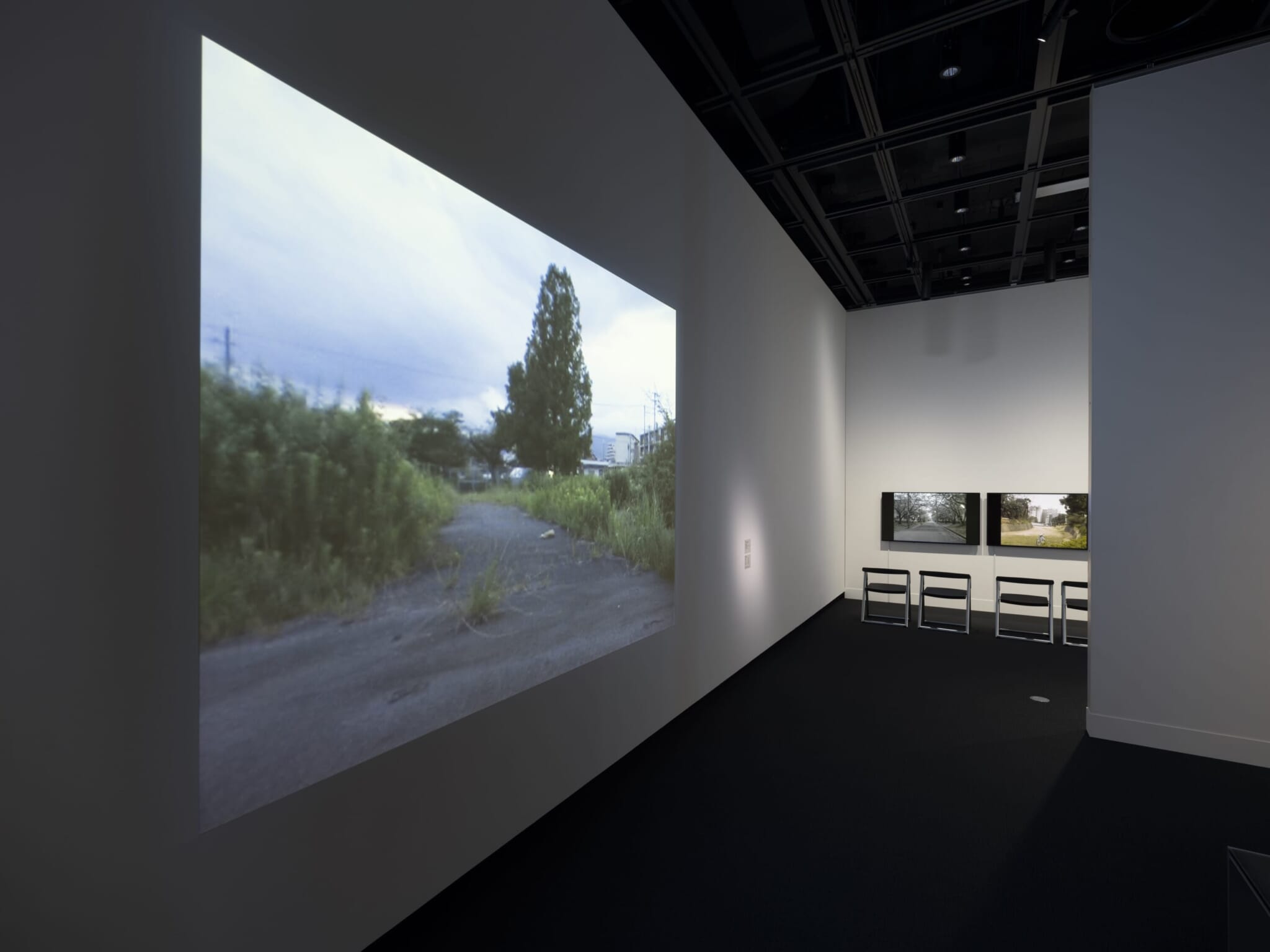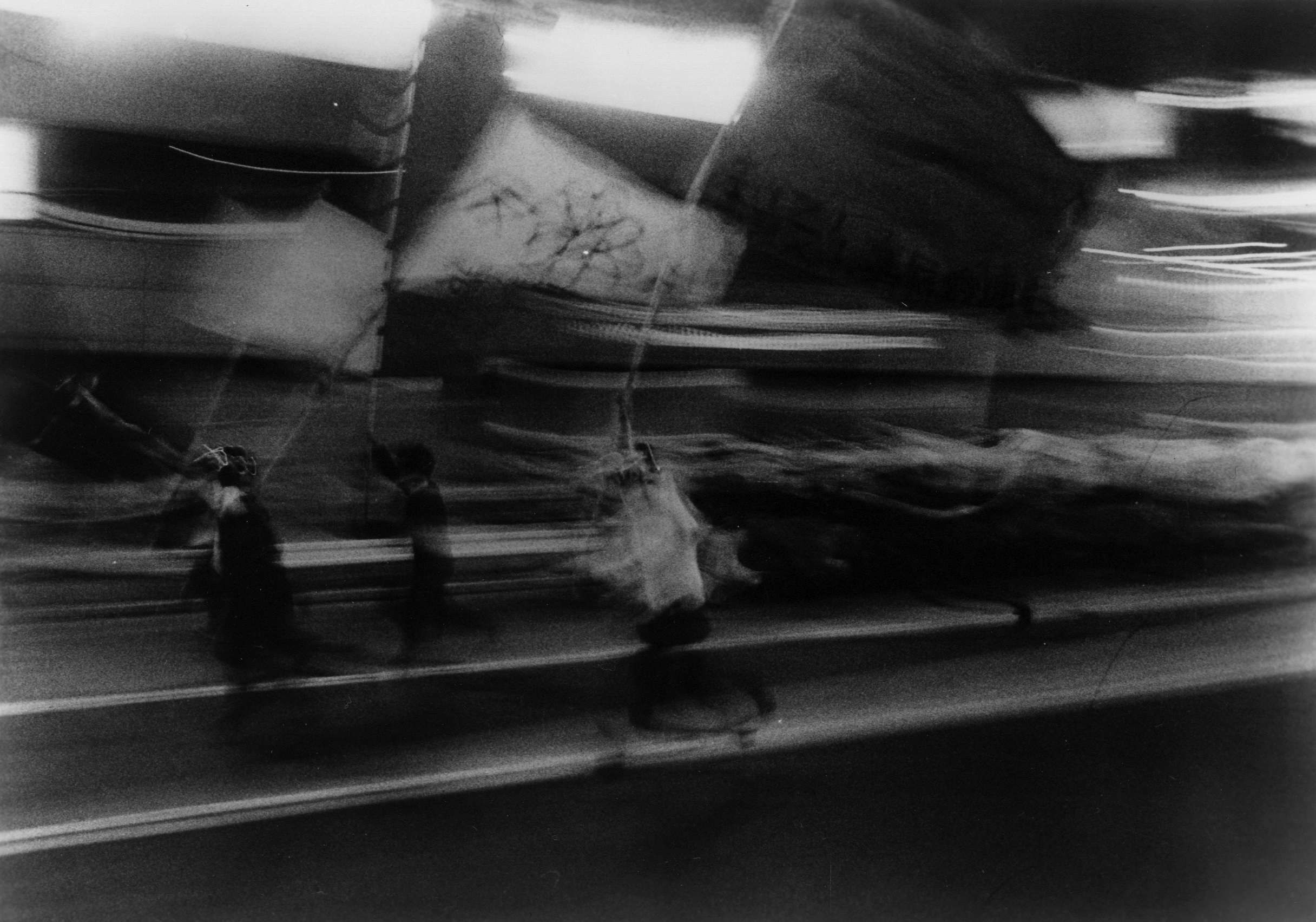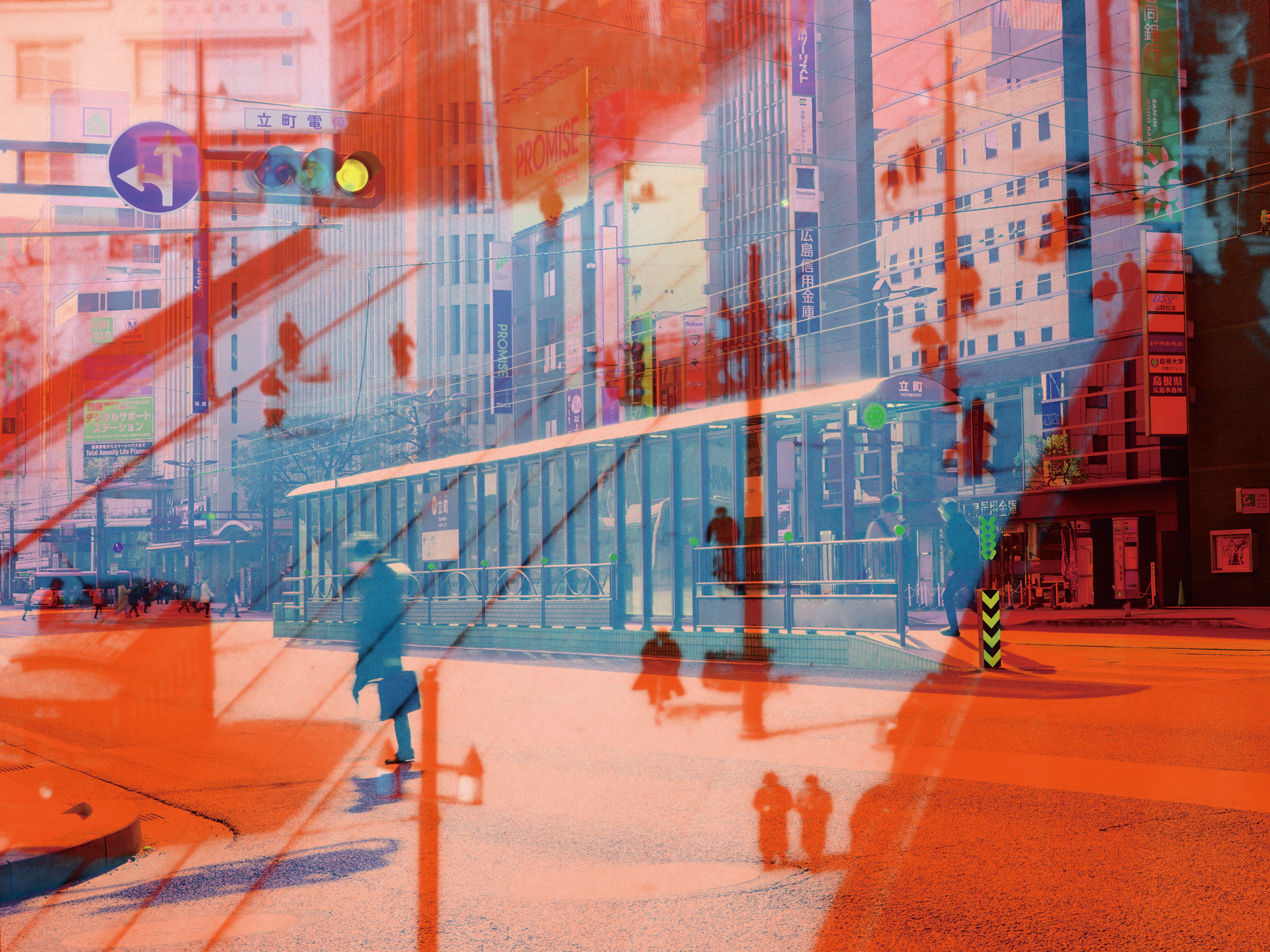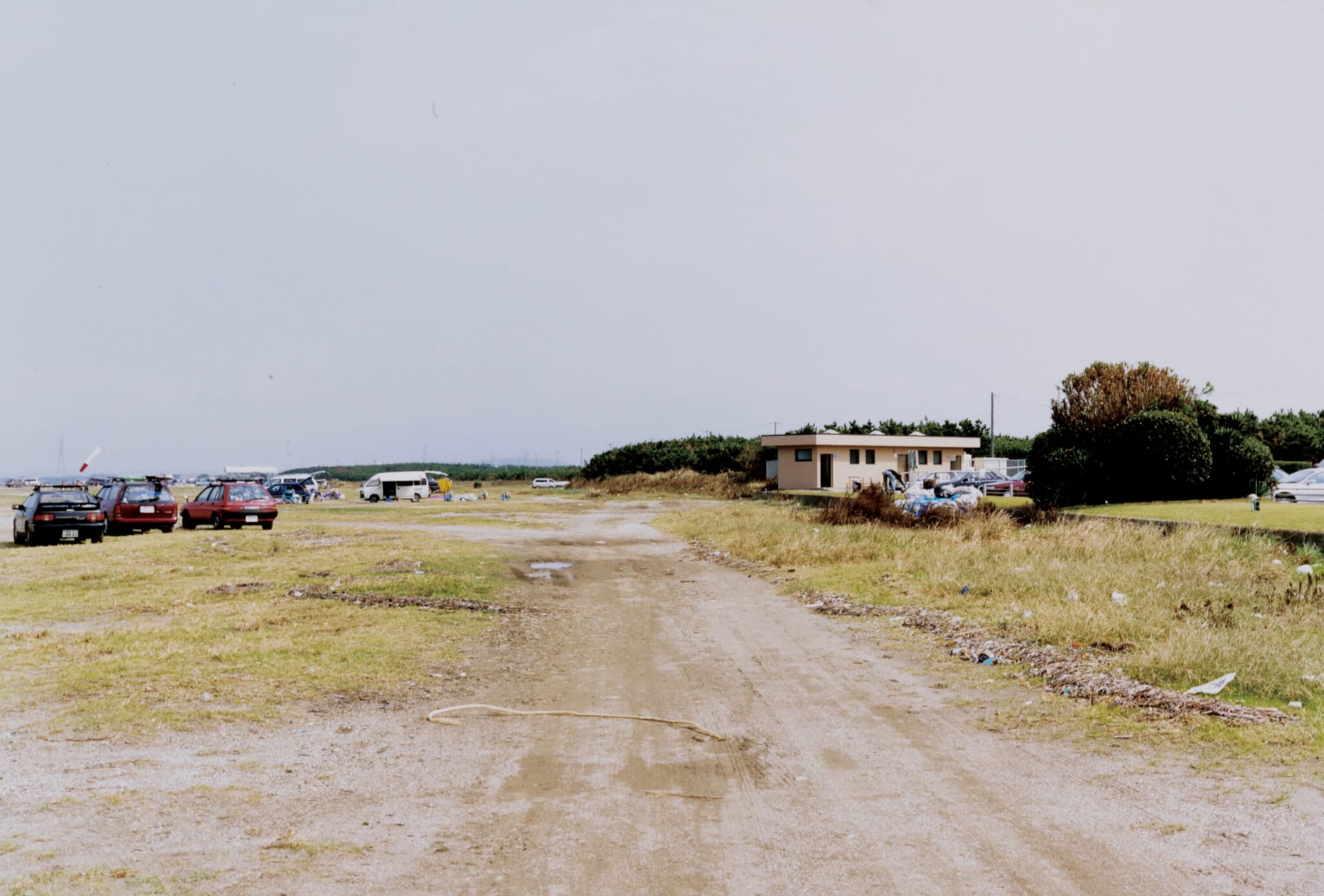The foundations of the cities we live in creak under the mental bricks and mortar of our phantom constructions; the remembered and dreamed-of cities that each of us lay over the routes of our daily lives. These festively competing topographies, built on the soil of done-but-not-dusted centuries, reach up in a riot of color and history to the hazily shifting skylines of ages yet-to-come.
These urban abstractions, however, in all their diverse and personal splendor, are constructed on frameworks prepared by other hands. The templates that are set for us, the concrete and inflexible cities where we dream our dreams, are laid out by creators of uncertain benevolence, with intentions and interests that are often opaque and ambiguous by design.

From After the Landscape Theory, 2023,Tokyo Photographic Art Museum. Photo by Shu Nakagawa
Landscape Theory
The influences and tensions exerted by overlapping realities, as well as the notion of a sinister and inorganic guiding hand, seem to have been central to the work of the pioneering Japanese writer and activist Masao Matsuda. In his works discussing landscape theory, Matsuda, who lived a colorful and unconventional life guided by his anarchist principles, addresses the potential for artists to reveal the invisible but inescapable imposition of authority over the everyday environments of our lives. Matsuda, as well as like-minded creatives, director Masao Adachi, screenwriter Mamoru Sasaki and photographer Takuma Nakahira, saw that only new and challenging art informed by these ideas, could adequately address the socioeconomic upheavals of life in the high-pressure political atmosphere of late 1960s Japan.
“After the Landscape Theory,” a thought-provoking exhibition at The Tokyo Photographic Art Museum, takes Matsuda’s still-relevant ideas as a starting point, before making a wider enquiry into the meaning of the term “landscape,” and the importance of its place in the work of filmmakers and photographers. The exhibits are presented in reverse chronological order, stretching back from already-poignant pandemic-era images, to the high-contrast political excitement of Matsuda’s contemporaries.

OSHIMA NAGISA, FROM “THE MAN WHO LEFT HIS WILL ON FILM”, 1970 (FILM ARCHIVE)©OSHIMA PRODUCTIONS LTD. COOPERATION: NATIONAL FILM ARCHIVE OF JAPAN
The Uncertain Future
There is a decidedly urban emphasis throughout the works displayed; a focus that seems understandable in any exploration of landscape, as it relates to the personal and political, in a country where 90% of the population are residents of cities. Matsuda’s ideas were formed at a time when the youth of Japan were flowing into cities, the limits of which were conversely flowing outwards. This expansionary drive aimed at accommodating and capitalizing on the newly abundant workforce, was the cause of a creeping homogenization and a blurring of the previously clear lines between the rural and the urban.
The conceptual centerpiece of the exhibition is a screening of Masao Adachi’s 1969 film, A.K.A. Serial Killer, an almost uniquely literal attempt to see and document the world through another’s eyes. The film, created after the events in question, follows in the itinerant footsteps of then 19-year-old Norio Nagayama whose brutal and seemingly senseless firearm killings of four people had shocked Japan. The actions of Nagayama, an unskilled worker who had left Hokkaido for the promise of a post-Olympics Tokyo, had caused many to reflect on the uncertain future facing a young and dispossessed population who had been set adrift on the unstoppable seismic waves of modernization. The film is a fascinating and unsensational attempt to put the ideas of landscape theory into practice, by seeking out the unseen truths and potentially ugly possibilities inherent in an unexamined society.

SASAOKA KEIKO, FROM THE SERIES ‘PARK CITY,’ 2022, COLLECTION OF THE ARTIST
The Presence of Humans
The work of Norio Imai shows obsessively documented scenes of everyday life in the Abenosuji district of Osaka. In sets of almost identical photos, the colorfully bustling car-and-bus-filled streets are recorded for posterity, along with the artist’s own movements, charted on densely collaged maps. Imai’s search for meaning in the ostensibly mundane seems to have led him to a somewhat meta investigation of his own creative routines and his place among the urban landscape that inspired him.
This focus on human activity directly contrasts with the the pensively empty spaces shown in the work of Yoshiko Seino. Photos from the artist’s series “Emotional Imprintings,” present the viewer with semi-rural sites of a sometimes-rough-and-ready nature, where the presence of humans can be sensed but not seen. Seino’s images, while not conventionally scenic by intention, have an open and invitational quality that gives them a surprising emotional depth.
Other affecting works include Maiko Endo’s “X,” a searching and personal video montage that has a mysterious, perhaps COVID-inspired air of apocalyptic calm, and Toshiko Takashi’s “Itami” series, consisting of Hi-8 video tableaux that focus on simple pleasures and the melancholy sweetness of passing time.
Time is also a matter of unavoidable consequence in Keiko Sasaoka’s “Park City” series depicting the current-day city of Hiroshima, sometimes blended in hallucinatory fashion with its pre-1945 self. The artist’s ethereally hazy and unfocused scenes show isolated figures moving across a city of sometimes startling stillness as though through a peaceful dream. In these quietly searching images, Sasaoka captures the spirit of the unfinished yesterdays that make the past not just a tangible presence, but an indelible and profound component of today.
The ideas and intentions behind the wide-ranging works displayed in “After the Landscape Theory” are unique to their creators, but each of them takes a closer-than-usual look at terrain made unremarkable by comforting or numbing familiarity. In doing so, they reveal the quiet truths and deeper meanings that, like invisible atoms, make up the landscapes of our lives.
After the Landscape Theory runs until November 5 at The Tokyo Photographic Art Museum.
1-13-3 Yebisu Garden Place, Mita, Meguro-ku
Updated On September 13, 2023









